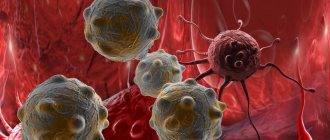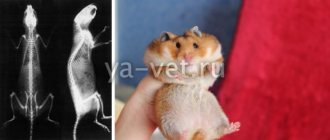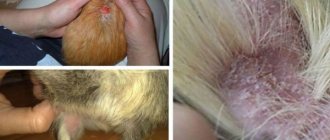Home / Papillomas
Hamsters are popular pets. But, just like all living beings, they get sick and need care. Common diseases include a tumor in a hamster, which can occur in any part of the animal’s body. Under the age of one year, an animal is less susceptible to the appearance of neoplasms, but if your pet is more than two years old, the appearance of oncology is not excluded.
All breeds of hamsters are susceptible to lumps. They come in different sizes and different densities (soft, hard). The lump may cause your pet severe pain or no pain at all.
If a tumor appears on the hamster’s body, you must contact a veterinary clinic for an examination and an accurate diagnosis.
Factors that cause compaction
New growths can be small or huge. According to veterinarians, tumors are more likely to occur in female Djungarian hamsters, which is associated with reproductive characteristics. Males of this species and representatives of other breeds suffer less from this disease.
The reasons that contribute to the appearance of compactions are:
- Fractures or bruises.
- Viral infections.
- Wrong diet.
- The presence of an inflammatory process in the body.
- Congenital pathology.
Depending on the reasons for the appearance of tumors, the types of tumors in hamsters will also be different.
Causes of fleas in hamsters
- Other rodents. You could buy an animal already infected with parasites. The rodent's neighbors in the pet store (guinea pigs, rabbits or rats) are carriers of small insects. It's no wonder they jumped onto your pet's fur.
- Pets. Fleas in hamsters could appear from proximity to a cat or dog. Animals that roam freely on the street are potential carriers of aphanipterosis. Cats bring insects on their fur, and they find a new habitat - the fur of a rodent.
- Shoes. Breeders, without knowing it, bring flea eggs into the apartment on their soles. In the apartment, insects hatch and attack domestic animals. Flea larvae can be brought in both from the street and from a warm, damp basement.
- Plants. Parasite larvae can get into the animal's cage with fresh grass that is fed to dwarf animals. To prevent this from happening, it is necessary to thoroughly wash fresh food.
Types of neoplasms in rodents
Bumps in rodents can appear on the limbs, skin or subcutaneous tissue (external), and internal tumors may also appear (on the uterus, in the intestines). Depending on the etiology, compactions are divided into:
- Benign neoplasms - occur after injuries, viral diseases or are caused by genetic failures. Outwardly, they resemble subcutaneous balls of small sizes and varying densities, which, with light pressure, move to the side. They should be removed to avoid the development of cancer.
- Malignant neoplasms develop either immediately or degenerate from benign ones. The oncological tumor is not localized, metastases spread to different organs of the rodent. Their appearance is provoked by genetic failures, poor nutrition (carcinogenic substances), and viruses.
- Inflammatory processes in tissues are also characterized by swelling, which occurs when pus or lymph accumulates in some areas.
An abscess in a hamster, tissue inflammation or a benign tumor can be treated, but oncology in an animal is incurable.
What to do if you find a tumor in your hamster?
A lump can appear anywhere in a furry cat, but most often the tumor occurs in the area:
In order to avoid illness in hamsters, it is necessary to frequently examine and feel your furry baby. Oncological diseases in the early stages are almost impossible to detect, but external seals can be diagnosed at home.
Important! First of all, it is necessary to urgently visit a veterinarian who will conduct an examination, take tests, establish a diagnosis and prescribe treatment. Remember that the disease develops quickly in hamsters due to the small size and aggressiveness of the viruses, and sometimes it happens that nothing can be done to help.
Treatment
To carry out the correct treatment, you need to pay attention to the condition of the tumor. If the area is not very red or swollen, then most likely surgery will not be required. If we are talking only about the inflammatory process, then it is best to prescribe a course of antibiotics or drugs that block tumor growth. If you take the medications on schedule, the abscess will not develop.
If the tumor has become too large, then you need to go to a hospital. In the hospital they must clean the wound and treat it with special compounds. Sometimes it becomes difficult for your pet to move without additional drainage. In such situations, you need to install a special drainage on the baby’s body. It is not possible to make such drainage at home.
If the wound breaks out on its own, then the breakout site should be treated with furatsilin and hydrogen peroxide. Here you don’t have to take your pet to the clinic, but you should definitely consult with a specialist. This is necessary to prevent your pet’s blood from becoming infected. Some infections can be fatal.
Prevention
To avoid illnesses in your pet, you need to take care of its physical condition. It is also important to worry about the emotional balance of the animal.
Hamsters should not be kept in the same cage. Pets can harm each other during a fight.
You also need to make sure that the accessories in the cage do not have sharp corners. Therefore, the choice of cage must be approached with extreme caution.
Hamsters chew the walls of their cage very often. Substances contained in the cage can harm the health of the pet. Coloring pigments cause harm to the internal organs of the animal. Thus, the formation of oncology of internal organs is possible.
It is important to choose the right food for hamsters. There are signs that distinguish bad food from good food. An ideal food should not:
- turn to dust in a bowl;
- contain dyes and preservatives;
- contain only whole grains;
- The food packaging must be hermetically sealed.
It is important to maintain the correct emotional state of the animal. The cage must be equipped with a running wheel. A good solution would be to equip the cage with a labyrinth or tunnel. You can let your pet out of the cage, but you must make sure that he does not get into minor troubles. For example, protect him from other pets. The hamster should not be allowed to fall. You need to make sure that he doesn’t get cuts while walking - keep him away from cutlery.
It is better not to take your pet outside, as it can catch a random draft. It often happens that the soil and grass outside are contaminated with parasitic organisms. If your pet gets an infection under the skin, the treatment process may take a long time. Sometimes an animal can even overheat in the sun, of course, which is very rare.
Your pet's cage should be in order. It is imperative to separate the animal's toilet area and the place where it eats. If your pet’s diet includes fresh fruit, then it is imperative to remove rotten remains, because they can harbor harmful bacteria.
The bedding in your pet's cage should be made from corn or cellulose meal. This type of bedding does not absorb pet urine and is also suitable for the formation of holes and internal tunnels. Hamsters love to make hiding places in this bedding. Mothers make a place in such bedding for their cubs. You can always be sure that they will not be deprived of attention.
In the end, we can say that cancer in animals, like in humans, cannot be cured. These animals do not tolerate surgery well and do not respond well to anesthesia and other medications. You should always monitor the external condition of your pets. Timely contact with a specialist will help avoid disastrous consequences.
>
Tumors in hamsters
Neoplasm on the neck
Thickening in the neck of hamsters can be caused by viral or bacterial infections, which lead to inflammation of the animal's lymph nodes. In such cases, Djungarian hamsters may squeak, because the area of inflammation hurts, but not always.
The main symptoms of the disease are loss of appetite due to pain and the inability to turn the head. When you feel the neck under the cheekbones, you will find hard balls - inflamed lymph nodes. A lump on the neck does not affect the life of the rodent, but it causes pain and inconvenience.
Signs of defeat
Rodent owners are convinced that the absence of cats or dogs in their home is a 100% guarantee that they are free of fleas. It is a myth.
One of the symptoms of the disease is itching. Signs of the presence of parasites:
- dark lumps of digested blood on the skin of a rodent;
- bald spots;
- scratching;
- skin inflammation.
Taking into account the fact that most parasitic species are dark in color and have decent body sizes, up to 3-5 mm, they are easy to notice with the naked eye under the pet’s fur.
Very often, parasites are selected for areas with shorter hair, ears or muzzle. The behavior of a hamster affected by fleas may remain the same for a long time. Itching begins to bother the animal when there is a significant increase in the number of insects in the cage, where the entire development cycle takes place.
Taking into account the fact that insects can move with powerful jumps, people will also feel their presence in the house and unpleasant bites.
Lumps on the abdomen
Sometimes neoplasms in rodents appear on the abdomen. In most cases, a tumor on the abdomen appears in mature females in the area of the mammary glands and can be either benign or malignant. Since this growth is not internal, it can be removed.
When examining males, it is necessary to remember that their marker glands are located on the abdomen, which are often confused with a sore. In Djungarian hamsters, the gland is yellowish in color and covered with a crust. Syrians have two of them, they are placed in front of the hind legs symmetrically on both sides and resemble an oval black bald spot.
This is not swelling in the hamster’s abdomen, but an anatomical formation and does not need to be treated. But in order to avoid inflammation or neoplasm in the area of the scent gland, an examination is necessary.
Other neoplasms
Hamsters are very active animals. Sometimes, if they jump unsuccessfully, they can damage their limbs. Careless handling of your pet can also lead to fractures, dislocations or bruises. If a tumor is detected on the paw, it is necessary to visit a veterinarian and examine the rodent to make sure whether the tumor is caused by an injury or a virus that causes the growth of bone tissue (osteosarcoma).
During the inflammatory process, a purulent cavity may form in the animal. An abscess in a hamster usually appears after fights or other injuries. It is accompanied by redness of the skin and painful sensations, and hair may fall out. At first the tumor is hard, but after the appearance of pus it becomes soft. As a treatment, the abscess must be opened and treated to avoid infection.
Preventive measures
As a preventative measure to reduce the risk of disease, it is recommended:
- Clean and wash the cage frequently.
- Proper nutrition (elimination of fatty and dangerous foods from the diet, introduction of vegetables and herbs).
- Avoid frequent mating. Childbirth undermines the body's defenses in females.
Compliance with the recommendations will help prevent viral diseases and reduce the risk of neoplasms.
If tumors are detected, do not self-medicate, but visit a specialist for a full examination.
Having noticed a tumor in a hamster, owners are often perplexed - what happened to their pet, where did this attack come from in a healthy, active animal. Few people realize that it could be cancer. Tumors almost never occur in hamsters under the age of one year, but among animals older than 2 years, oncology is very widespread.
What does a healthy hamster/chipmunk look like?
A pet that does not have a pathology is active, mobile, shows interest in everything that happens around and has an excellent appetite, stuffing its cheek pouches with food in reserve.
The eyes are beady, moist and clean, without discharge or pathology. The animal is well-fed (not obese!) and covered with smooth shiny hair without signs of damage to the integrity of the skin and the presence of parasitic lesions (lice, fleas, ticks, pathogenic fungi).
A healthy pet has well-formed, regular stools and urination that are free of blood or mucus. Normally, there is no discharge from natural orifices. The teeth have a bright orange hue and are long enough to capture and process food. Good health is indicated by a desire to communicate with other pets or with the owner.
A tumor is not always oncology
The diagnosis must be made by a qualified specialist in a veterinary clinic, but not everyone has the opportunity to get an appointment with a veterinarian. A preliminary conclusion can be made based on the localization of the formation:
- if the hamster has a lump on its neck, it may be an inflammation of the lymph node;
- a tumor on the abdomen in most cases is a neoplasm of the mammary gland;
- swelling of the cheek and swelling of the muzzle suggest a problem with the teeth or cheek pouches;
- swelling on the head, forehead or back may be the result of a hamster fight or other injury.
When examining the animal, you should remember the location of the marker glands in males, which are often mistaken for a sore.
In the Djungarian hamster it is located on the stomach, yellowish and covered with crusts. The Syrian hamster has two of them, symmetrically on the sides, in front of the hind legs. They look like a black oval bald spot. This is a normal anatomical formation, and there is nothing to treat here, but observation will not be superfluous: inflammation or neoplasm of the scent gland is often recorded in hamsters.
Abscess in a hamster
As a result of fights or other injuries, purulent inflammation may occur, which looks like a limited swelling. The lump on the side may well be an abscess rather than cancer. At first it is hard and painful, and the skin is red and hot to the touch. Then the tumor softens and fluctuation appears. Hair may fall out. At the final stage, the abscess spontaneously opens and a wound appears from which pus flows.
For an abscess in a hamster, treatment involves the use of systemic antibiotics (Baytril 2.5% subcutaneously 10 mg/kg body weight). Surgical treatment of the wound is necessary: opening the abscess, cleaning the cavity and washing with an antiseptic. The wound is washed every day and protected from re-infection.
If the abscess is not treated properly, the process becomes chronic and a fistula appears, which will be difficult to heal.
Tumor on a hamster's cheek
A special case of an abscess is inflammation of the cheek pouch, the most likely reason that a hamster has a swollen cheek. Injury occurs from the inside, with a sharp object or unsuitable food: wood chips, dry pasta, seeds and nuts in shell, hay. The wound gets infected and fester occurs.
When your pet's cheek is swollen, it is better not to hesitate to visit a doctor. Purulent inflammation spreads to the surrounding tissues, and next to the cheek there are the most important structures: the eyes, ears and brain. The pain does not allow the baby to eat, and the animal quickly weakens.
If the animal's cheeks are swollen symmetrically, they should be gently massaged towards the muzzle. Then the hamster will reflexively throw out the contents of the cheek pouch, and it will be clear whether there is a problem. If the seal is preserved, the contents are checked by pulling back the edge of the lips with your hand or a stick and at the same time pressing on the cheek under the ear. This must be done while firmly holding the hamster and trying not to damage the mucous membrane.
Sometimes it makes more sense to treat a swollen cheek in a clinic setting under anesthesia. The doctor will be able to completely turn out the cheek pouch, remove foreign objects, rinse with an antiseptic (an aqueous solution of furatsilin, chlorhexidine), open the abscess and empty the cavity of pus.
When a hamster has a bump on its cheek, in addition to the cheek pouches, the doctor must check the animal’s bite.
Rodents' teeth grow throughout their lives and should be worn down normally. If this does not happen, the molars grow excessively - this is called malocclusion.
For dental problems:
- loss of appetite (or complete refusal to eat);
- discharge from the nose or swollen eye;
- abscess on the cheek, swelling.
If the length of the teeth is not adjusted, the hamster will die.
A tumor in a hamster’s neck can also indicate an inflammatory process in the oral cavity - then the nearest, “barrier” lymph node enlarges and looks like a hard lump in the area under the lower jaw. Lymph nodes also enlarge with a systemic infectious disease.
What to do if your hamster has a swollen paw
If your pet's paw is swollen, then the first thing to suspect is a closed fracture of the hamster's paw.
An accurate diagnosis can be obtained by taking an x-ray using a good quality digital device. True, this is more of a scientific interest - neither surgery nor a cast will be performed in a veterinary clinic, only complete rest is prescribed.
What to do if your paw is swollen and the cause is unknown:
- Place in a small carrying container with solid walls without rods.
- Use paper towels instead of bedding.
- Dosed, complete feeding, monitor the presence of appetite.
- Examine the animal, checking whether a wound has appeared on its paw. Sometimes, even with open fractures, sticky hair makes it difficult to see the wound. If the animal fought with a relative, or was otherwise injured, the lump on the paw may turn out to be an abscess. Then the abscess sooner or later opens up, and it is treated like an open wound, washed daily with an antiseptic.
In the worst case scenario, the tumor on the paw turns out to be osteosarcoma . This is a malignant oncological disease that progresses rapidly and cannot be cured.
Over time, the paw is no longer visible; the entire limb is a tumor mass that spreads to the body of the animal. Osteosarcoma is more common in older animals (1-2 years).
Where does a hamster get fleas?
The hamster is one of the cleanest animals. So cute, active and cheerful, just watch him for a few minutes and a smile will shine on your face. He can always please the owner, without running around spreading wool all over the apartment. He still eats little. The most important thing is that he sits in his corner and does not leave the house. Where could he have picked up these parasites?
Firstly, flea symptoms can be confused with others. If your hamster is constantly itching, this is the main sign of the presence of parasites. But such symptoms can indicate many other diseases. Most of them are skin related.
Do you suspect that your hamster has fleas? This is such a clean animal that if they exist, it’s not his. Other pets who are outside from time to time may have brought them home. They began to multiply and did not bypass the rodent. Some parasites do not stay on the animal that brought them home. Walking around the apartment, there is a high probability of ending up in a cage where a fluffy is sleeping. But even if there really are pests, there is no need to fear for the animal’s life. His body is so small that not much can fit on him. These parasites are poorly adapted to life on hamsters, so they can leave it on their own. Those that remain are quite small, it is easy to get rid of them since they themselves are not averse to changing the donor.
Why does a hamster have big testicles?
After the male reaches puberty, inexperienced owners begin to sound the alarm, figuring out what to do if the hamster’s testicles are too large. But large testes relative to body size in rodents are a common occurrence. In a Syrian hamster, they become noticeable (a pair of tubercles in the lower abdomen) at the age of 2 months, and after another month the hair on them thins out and you can notice that the testicles have greatly enlarged. Hamsters can have unilateral cryptorchidism - when one testis descends into the scrotum, and the second remains in the abdominal cavity. Then the swelling in the tail area will be one-sided.
Consider the possible reasons why your hamster's testicles are swollen.
Puberty
When the animal is ready to reproduce, seminal fluid accumulates in the testes. Often, a “tumor on the butt” of a young Dzungarian male turns out to be a man’s penis of normal size.
Hormonal disbalance
Most often, when keeping males and females in the same room (but in different cages).
Inflammatory process
Red and hot skin on the testes, signs of pain are signs of infection, orchitis. Treatment is carried out with antibiotics, but not always successfully.
Oncology
There are both benign and malignant testicular tumors (seminoma). Regardless of the type of formation, the only treatment is removal of the affected organ (castration) under general anesthesia. Oncology is characterized by a one-sided lesion, in contrast to orchitis.
How to get rid of fleas on a hamster's fur
At the moment, not every owner of a small rodent knows what to do if the hamster has various types of fleas. In this case, the pet owner does not need to panic, but should immediately contact the veterinarian who treats the animals.
It is the doctor who prescribes specific anti-flea medications. Then the pet owner buys ready-made insecticidal preparations.
Modern manufacturers produce a variety of insecticidal products. This allows the buyer to choose those drugs that are most convenient to use.
Treating all pets and your home for fleas
When fleas appear in an apartment, the tenant treats both all pets and the apartment itself.
When sanitizing a room in which fleas live on hamsters, the tenant performs the following actions:
- thoroughly vacuums his home, and then shakes out the vacuum cleaner (or throws out the disposable dust bag). A household member carries out such cleaning every day or at least 2 times in 7 days;
- vacuums a sofa or other furniture on which a cat or dog is sleeping, as well as carpets and dusty corners;
- After using the vacuum cleaner, he does a wet, thorough cleaning of his home.
When sanitizing his private household or apartment, a household member uses various insecticidal powders for indoor carpets or sprays (Raid, Combat, Raptor).
Then the pet owner dilutes 1 ampoule of this product (5 ml) with 3 liters of water and treats their home using a spray bottle.
When carrying out hamster sanitation, you need to keep in mind the following nuances:
- anti-flea sprays are effective for 2 weeks - 5 months;
- insecticidal drops are valid for a maximum of 1 month. They are designed for the specific weight of the pet. The household member squeezes the contents of the tube onto the skin of the cat or dog’s withers;
- Special flea shampoos have a short shelf life. Therefore, they are used only if fleas have already appeared on a cat or dog.
After the first treatment with insecticidal shampoo, the pet owner puts an anti-flea collar on the pet.
Hamster handling
Even if there are no cats or dogs in the house, hamsters still have fleas. In the event of a flea infestation, the rodent cannot avoid undergoing unpleasant disinsection. However, today there are practically no highly effective anti-flea products for such animals on sale.
Sellers of veterinary pharmacies often offer their clients those drugs that are made for dogs and cats, but their size is much larger than such rodents. After all, a hamster weighs approximately 50 grams.
This doctor prescribes the following highly effective anti-flea drugs for the hamster:
- aerosols;
- drops;
- powders.
Aerosol
When treating a hamster infected with fleas, its owner uses the following aerosols:
- "Bars" - fipronil 0.3%. To get rid of hamster fleas forever, the resident sprays 0.25 ml of this product on the rodent (presses the dispenser once);
- "BioVax";
- “Le Artist” is made from various plant components.
In such a situation, the resident sprays this product evenly over the hamster. Also, the owner of the animal sprinkles it on a cotton pad, and then wipes it over his pet, lifting its fur.
Drops
The drops are also a highly effective flea treatment for hamsters. When using this drug, the owner of the hamster drips 2-5 drops onto his withers and along the hamster's spine.
When treating a hamster for fleas, its owner uses the following drops:
- Celandine;
- Stronghold;
- Frontline;
- Petvital Canina Verminex.
Such insecticides not only instantly kill fleas, but also prevent re-infection of the hamster.
Powder
Not every rodent owner knows how to properly remove fleas from a hamster. This can be done using an insecticidal special powder such as anti-flea powder.
When this product is used correctly, the household powders and cleans the hamster’s fur, and then the small pests quickly die. Moreover, this powder is made of soft small particles that do not damage the hamster’s skin.
When treating a sick hamster, a household member uses the following powders:
- Savic Blue Cloud Dust (Savik);
- Insectal.
The powder is distributed in a thin layer over the entire body of the hamster (pollination occurs). The main thing is not to get into the hamster's mouth and nose.
Cage disinfestation
In addition to carrying out anti-flea treatment on the hamster itself at home, you also need to change its bedding - from old to new. Moreover, you can, for example, use a bedding made of cedar shavings, which repel fleas.
The cage and hamster accessories are thoroughly washed with hot running water and soap once every 7 days.
IS IT POSSIBLE TO BATH HAMSTERS? DO HAMSTERS HAVE FLEAS?
Surgical intervention
If a tumor is detected in your pet, you must take a risk and agree to surgical removal. The formations in rodents grow rapidly, the skin cannot withstand it and bursts, forming a fetid, non-healing ulcer. The tumor mass prevents the animal from moving; sometimes the hamsters themselves try to chew off the foreign tissue and die from blood loss. If a limb is affected by cancer, amputation is the best option. If the tumor is on the body, it must be removed while it is still small, otherwise it will be difficult for the surgeon to close the skin defect after removal.
The use of inhalation anesthesia in recent years has increased the survival rate of rodents after surgery. The doctor must have experience working with rodents and ensure that the tiny organism does not become hypothermic during anesthesia. A starvation diet before surgery is not prescribed, and is even harmful.
Removing the tumor itself will not cure the hamster; it will remain sick and may die from tumor metastases to other organs (lungs, liver). But it can improve the quality of life.
If internal organs are affected by cancer, one can only guess about this by the symptoms or asymmetry of the abdomen. In this case, the operation does not make sense and the operation comes down to euthanasia on the surgical table.
Causes
The causes of tumors can be different. These include bites received during fights, various scratches received when the pet collided with sharp corners of furniture, and other wounds. The cause of the tumor may be poor quality food, improperly removed bedding in the cage, draft or stress. It is necessary to protect them in every possible way from too much noise, from hypothermia, and from aggressive environmental influences.
What to do if you find a tumor in your hamster?
If a benign tumor is discovered in a pet, then you can resort to preventive measures; if a malignant tumor is discovered, then you need to resort to measures to remove it. The growth can only be removed through surgery. Professional clinics will create all the conditions for comfortable rehabilitation of your pet, as well as to prevent the recurrence of inflammation.
The sooner the owner contacts the veterinarian, the faster the doctors will remove the tumor, and the pet will suffer less. Painful sensations in hamsters are due to the fact that the wound grows, the skin bursts, and pus cells form ulcers on the body. Very often, the animal, unable to bear the pain, tries to chew off the wound. But such an “operation” will only lead to unnecessary blood loss and, as a result, death.
If a pet develops cancer, then the only measure that should be used in such a situation is amputation. Of course, when it comes to soft tissue tumors, the best outcome is euthanasia.
For the operation, inhalation anesthesia is used, which helps reduce pain during the post-rehabilitation period. It is important to ensure that the rodent does not get hypothermia, otherwise re-infection of the tissues cannot be avoided. During the post-rehabilitation period, you cannot keep your pet on a hungry diet. Otherwise, the wound will heal longer than usual.
It is important to know that after removal of the cancer, the hamster can also die due to the spread of metastases. They can damage internal organs, such as the lungs and liver. Cancer can damage your pet's internal organs. This is evidenced by the curvature of the body.











